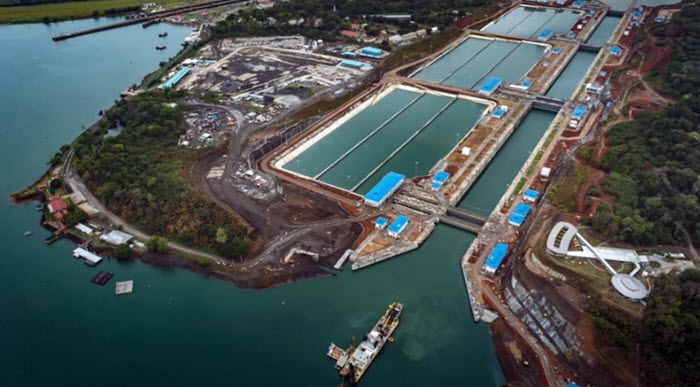Most canals connect lakes and rivers. The Panama Canal, though, makes it possible to transport goods and tourists from the Atlantic Ocean to the Pacific and vice versa. Both the Cape Horn route around the tip of South America and the Northwest Passage beyond the northern continent are perilous alternatives with submerged rocks and stormy weather.
Completed in 1914, the Panama Canal is vastly different than the Suez Canal that connects the Red Sea to the Mediterranean. The Suez waterway is a level cut through desert landscapes. But in Central America, even at the narrowest land bridge between the Atlantic and the Pacific, it wasn’t feasible to make a sea-level cut to form the canal. Different tides at both ends of the canal would have seawater sloshing back and forth in a trench that would need to be over 100 feet deep. Then there was the wild Chagres River which drained into the Atlantic with ever-changing force. At times it brought ferocious floods. At 40 miles of length, the Panama Canal is only one-third as long as the Suez. But its terrain is vastly more difficult. At the highest elevation, 85 feet above sea level, a large dam now blocks the flow of the river. The resulting Lake Gatun is the biggest engineered lake in the world.
In order to rise up to Gatun and then down again to Panama City, ships must pass through three locks. The first one raises the vessel 85 feet to enter Gatun. After passing through the tight Culebra Cut, the ship passes through Pedro Miguel Locks to be lowered down into Miraflores Lake. Finally, Miraflores Locks drop it to sea level and open the passage into the Pacific Ocean.
Water loss at Gatun, each time a ship passes through a lock, was a problem recognized early. The new lock system, opened in 2016, features a clever recycling mechanism through water saving basins that recycles 60% of the lake water. But in 2019, severe drought hit the area, following an earlier drought in 2015-16. Those droughts are associated with El Niño type climate fluctuations. The ongoing climate change could make them appear more frequently. Lower lake levels mean restrictions in the size and draft of ships that can pass through the canal, and therefore diminished trade and flow of goods. The next two decades will show what nature has in store for the Panama Canal.
Rudi Kiefer, Ph.D., is a professor emeritus of physical science at Brenau University. His column appears Sundays and at gainesvilletimes.com.
Get Vaccinated and stay safe!!
